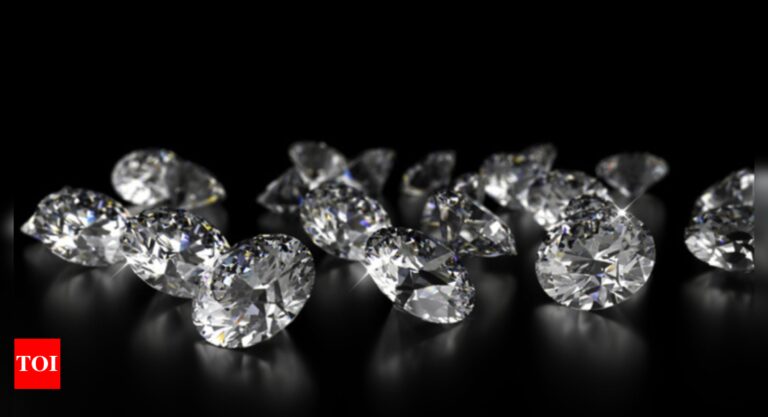
[ad_1]
NEW DELHI: A team of researchers led by physical chemist Rodney Ruoff at the Institute for Basic Science in South Korea has developed a groundbreaking technique to synthesize diamonds at normal atmospheric pressure, without needing a starter gem. This innovative method, published in the journal Nature, could revolutionize the way diamonds are produced in laboratories.
Traditionally, natural diamonds form deep within Earth’s mantle under extreme pressures and temperatures. The conventional high-pressure and high-temperature (HPHT) method to create synthetic diamonds mimics these conditions, requiring several gigapascals of pressure and temperatures over 2,700 degrees Fahrenheit (1,500 degrees Celsius). However, this method is complex, time-consuming, and produces relatively small diamonds, a Live Science report said.
Ruoff’s team has devised a novel approach that bypasses some of the drawbacks of HPHT and other synthesis processes. They used electrically heated gallium with a bit of silicon in a graphite crucible, housed in a chamber maintained at sea-level atmospheric pressure. Superhot, carbon-rich methane gas was flushed through the chamber, catalyzing the formation of diamonds. Remarkably, diamonds began to form within just 15 minutes.
“For over a decade I have been thinking about new ways to grow diamonds, as I thought it might be possible to achieve this in what might be unexpected (per ‘conventional’ thinking) ways,” Ruoff told Live Science via email.
The researchers found that a gallium-nickel-iron mixture, with a pinch of silicon, was optimal for catalyzing diamond growth. Within two and a half hours, a more complete diamond film formed, which was largely pure but contained a few silicon atoms.
However, the new method has its challenges. The diamonds produced are tiny, much smaller than those created by HPHT, making them unsuitable for jewelry. Nevertheless, these small diamonds could have technological applications, such as in polishing and drilling. The low-pressure process might also enable significant scaling up of diamond synthesis, the Live Science report said.
“In about a year or two, the world might have a clearer picture of things like possible commercial impact,” Ruoff said.
The minutiae of the mechanism that forms the diamonds are still being studied, but the team believes a temperature drop drives carbon from the methane toward the crucible’s center, where it coalesces into diamond. Silicon appears to act as a seed for the carbon to crystallize around, as no diamonds form without it.
This groundbreaking technique opens up new possibilities for diamond synthesis, potentially transforming industrial applications and paving the way for more efficient production methods.
Traditionally, natural diamonds form deep within Earth’s mantle under extreme pressures and temperatures. The conventional high-pressure and high-temperature (HPHT) method to create synthetic diamonds mimics these conditions, requiring several gigapascals of pressure and temperatures over 2,700 degrees Fahrenheit (1,500 degrees Celsius). However, this method is complex, time-consuming, and produces relatively small diamonds, a Live Science report said.
Ruoff’s team has devised a novel approach that bypasses some of the drawbacks of HPHT and other synthesis processes. They used electrically heated gallium with a bit of silicon in a graphite crucible, housed in a chamber maintained at sea-level atmospheric pressure. Superhot, carbon-rich methane gas was flushed through the chamber, catalyzing the formation of diamonds. Remarkably, diamonds began to form within just 15 minutes.
“For over a decade I have been thinking about new ways to grow diamonds, as I thought it might be possible to achieve this in what might be unexpected (per ‘conventional’ thinking) ways,” Ruoff told Live Science via email.
The researchers found that a gallium-nickel-iron mixture, with a pinch of silicon, was optimal for catalyzing diamond growth. Within two and a half hours, a more complete diamond film formed, which was largely pure but contained a few silicon atoms.
However, the new method has its challenges. The diamonds produced are tiny, much smaller than those created by HPHT, making them unsuitable for jewelry. Nevertheless, these small diamonds could have technological applications, such as in polishing and drilling. The low-pressure process might also enable significant scaling up of diamond synthesis, the Live Science report said.
“In about a year or two, the world might have a clearer picture of things like possible commercial impact,” Ruoff said.
The minutiae of the mechanism that forms the diamonds are still being studied, but the team believes a temperature drop drives carbon from the methane toward the crucible’s center, where it coalesces into diamond. Silicon appears to act as a seed for the carbon to crystallize around, as no diamonds form without it.
This groundbreaking technique opens up new possibilities for diamond synthesis, potentially transforming industrial applications and paving the way for more efficient production methods.
[ad_2]
